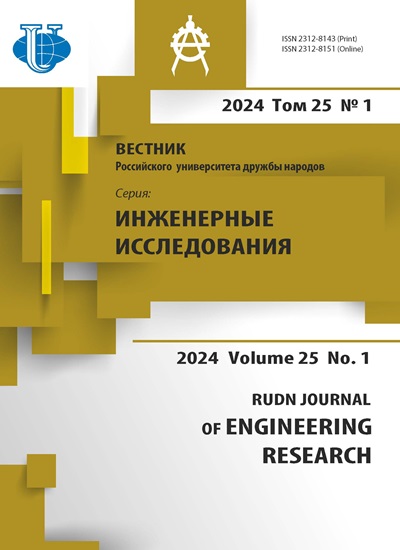Numerical simulation of aerodynamic interference between ejected payload and the parent aircraft
- Authors: Bykov L.V1, Pashkov O.A1, Pravidlo M.N2, Yanyshev D.S1
-
Affiliations:
- Moscow Aviation Institute (National Research University)
- State Machinery Design Bureau «Vympel»
- Issue: Vol 19, No 1 (2018)
- Pages: 22-37
- Section: Aviation and rocket and space technology
- URL: https://journals.rudn.ru/engineering-researches/article/view/18627
- DOI: https://doi.org/10.22363/2312-8143-2018-19-1-22-37
Cite item
Full Text
Abstract
The purpose of this paper is to develop reliable methodology for numerical modeling of the interference between parent aircraft and ejectable payload and to investigate the influence of the interference on aerodynamic characteristics of the payload. An appropriate algorithm for the said problem is proposed. A mathematical model for supersonic flow around a solid body as well as its finite volume discretization process is described. In the presented mathematical model, a turbulence model is added to the Navier-Stokes system of equations. Namely, Menter’s SST model was chosen. Coupled solver algorithm is reviewed. Implicit Euler scheme is used for time discretization and Newton’s method is implemented to linearize the system of equations. The specifics of determining the appropriate boundary conditions and nondimensionalization of the aerodynamic coefficients are described. The calculations for the isolated payload were performed on an unstructured grid with 9 million cells and for the payload interfered by the parent aircraft - on a 24 million grid. As a result, the summarized aerodynamic characteristics for the payload were obtained for the isolated payload as well as for the payload in presence of the parent aircraft. The characteristics of the isolated object are compared with the ones of the object in presence of the parent aircraft in two different positions - Y rel = 0 m and Y rel = 0.6 m. The developed method was verified using wind tunnel data. It was identified that in presence of the parent aircraft, the coefficients of normal and side force are not zero as opposed to the isolated payload. Moving away from the parent aircraft decreases the interference and thus the side force, as well as the pitch and yaw torques. The obtained results show that the proposed method could be used in other cases of aerodynamic interference between moving objects.
About the authors
Leonid V Bykov
Moscow Aviation Institute (National Research University)
Author for correspondence.
Email: bykov@mai.ru
Сandidate of Technical Sciences, Director of the Institute of additional vocational education, associate professor at Aerospace Thermal Engineering Dept., Moscow Aviation Institute (National Research University), Moscow. Research interests: high-enthalpy flows, heat and mass transfer, gas dynamics, turbulence, aircraft aerodynamics
4, Volokolamskoe shosse, Moscow, 125993, Russian FederationOleg A Pashkov
Moscow Aviation Institute (National Research University)
Email: gfon2@yandex.ru
Candidate of Technical Sciences, researcher at Aerospace Thermal Engineering Dept., Moscow Aviation Institute (National Research University), Moscow. Research interests: heat and mass transfer, gas dynamics, turbulence, aircraft aerodynamics
4, Volokolamskoe shosse, Moscow, 125993, Russian FederationMikhail N Pravidlo
State Machinery Design Bureau «Vympel»
Email: bykov@mai.ru
Doctor of Technical Sciences, Director of the Scientific Research and Flight Test Centre at “Vympel” State Machine Building Design Bureau, Moscow. Research interests: flight dynamics of control objects, dynamics of complex mechanical systems as a part of aircraft systems
90, Volokolamskoe shosse, Moscow, 125424, Russian FederationDmitry S Yanyshev
Moscow Aviation Institute (National Research University)
Email: dyanishev@gmail.com
Сandidate of Technical Sciences, associate professor at Aerospace Thermal Engineering Dept., Moscow Aviation Institute (National Research University), Moscow. Research interests: high enthalpy flows, heat and mass transfer, gas dynamics, turbulence, radiative heat transfer
4, Volokolamskoe shosse, Moscow, 125993, Russian FederationReferences
- McBride B.J., Gordon S., Reno M.A. Coefficients for Calculating Thermodynamic and Transport Properties of Individual Species // National Aeronautics and Space Administration. Office of Management Scientific and Technical Information Program. 1993.
- Barth T.J., Jespersen D. The design and application of upwind schemes on unstructured meshes // Technical Report AIAA-89-0366. AIAA 27th Aerospace Sciences Meeting, Reno, Nevada. 1989.
- Menter F.R. Two-Equation Eddy-Viscosity Turbulence Models for Engineering Applications // AIAA Journal. August 1994. No. 32(8). Pp. 1598–1605.
- Bykov L.V., Molchanov A.M., Shcherbakov M.A., Yanyshev D.S. Vychislitel’naja mehanika sploshnyh sred v zadachah aviacionnoj i kosmicheskoj tehniki [Computational continuum mechanics for problems of aerospace engineering]. Textbook. М.: OOO «Lenand» Publ., 2015. 668 p. (in Russ.).
- Venkateswaran S., Weiss J.M., Merkle C.L. Propulsion Related Flowfields Using the Preconditioned Navier–Stokes Equations // Technical Report AIAA-92-3437. AIAA/ASME/SAE/ASEE 28th Joint Propulsion Conference, Nashville, TN. July 1992.
- Weiss J.M., Smith W.A. Preconditioning Applied to Variable and Constant Density Flows // AIAA Journal. November 1995. No. 33(11). Pp. 2050–2057.
- Roe P.L. Characteristic based schemes for the Euler equations // Annual Review of Fluid Mechanics. 18. 337–365. 1986.
- Roe P.L. A survey of upwind differencing techniques // Lecture Notes in Physics, 1989, 323, 69.
- Weiss J.M., Maruszewski J.P., Smith W.A. Implicit Solution of the Navier-Stokes Equations on Unstructured Meshes // Technical Report AIAA-97-2103. 13th AIAA CFD Conference, Snowmass, COJuly 1997.
- Hutchinson B.R., Raithby G.D. A Multigrid Method Based on the Additive Correction Strategy // Numerical Heat Transfer. 9. 1986. 511–537.
















